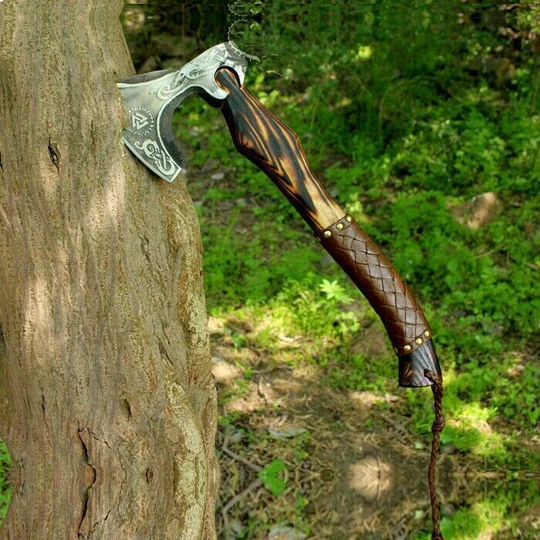
Introduction
The Viking axe has long been an iconic symbol of Norse history and culture, representing power, craftsmanship, and battle prowess. Handcrafted Viking axes hold even more appeal, as each piece carries the spirit of ancient traditions combined with the artistry of skilled modern artisans. This article explores the unique qualities, crafting processes, and modern significance of these exceptional tools. Whether you are a collector, an enthusiast of Viking history, or someone looking for an axe for outdoor use, the handcrafted Viking axe offers a deep connection to a storied past.
The History and Significance of Viking Axes
The Viking axe was more than just a tool for combat or everyday use; it was a symbol of status and identity among the Norse people. Viking warriors favored axes for their versatility, strength, and effectiveness in battle. Unlike swords, which were more expensive to produce and were often reserved for the elite, axes were widely accessible and highly functional in warfare. From smaller hand axes, perfect for close combat, to larger two-handed battle axes designed for maximum impact, the Viking axe came in various forms to meet different needs.
Beyond battle, axes were essential in Viking society for tasks like chopping wood, farming, and shipbuilding. The Vikings’ maritime adventures and raiding expeditions across Europe were made possible in part by their ability to craft ships with tools like the axe. Today, the handcrafted Viking axe serves as both a historical artifact and a reminder of the ingenuity of the Viking people.
Crafting Techniques of Viking Axes
Traditional Forging Methods
Handcrafted Viking axes are often made using traditional forging methods that have been passed down through generations. The process begins by heating high-quality steel until it becomes malleable, allowing the blacksmith to shape it into a blade. During the forging process, the blacksmith hammers the steel repeatedly to form the desired shape and edge. This not only helps shape the axe head but also strengthens the metal, creating a durable and sharp blade.
The edge of the Viking axe was often welded with a higher carbon steel to ensure a sharper cutting edge, while the body of the axe could be made from softer iron or steel. This combination allowed the axe to withstand the rigors of battle while maintaining an effective cutting surface.
Modern Handcrafting Techniques
Today, artisans blend traditional techniques with modern innovations to produce high-quality handcrafted Viking axes. Many blacksmiths still prefer to hand-forge their blades, but the availability of modern tools such as power hammers and grinders can speed up the process while maintaining craftsmanship quality. In modern handcrafting, attention to detail remains crucial, with many axes still being finished by hand to ensure each piece meets the artisan’s standards.
Custom-made Viking axes often feature intricate designs and decorative elements, adding to their uniqueness and appeal. The fusion of traditional methods with contemporary techniques allows for a perfect balance of functionality and artistic expression in handcrafted Viking axes.
Materials Used in Handcrafted Viking Axes
Steel Types for the Blade
The most critical part of any Viking axe is its blade. Historically, Viking axe heads were forged from iron and steel, with higher carbon steel being used for the cutting edge to enhance sharpness and durability. Modern handcrafted Viking axes are often made from high-carbon steels such as 1055, 1060, or 5160 steel, which provide excellent edge retention and toughness. Some artisans use Damascus steel to create a distinctive layered pattern on the blade, adding both beauty and strength.
Wood for the Handle
The handle of a handcrafted Viking axe is typically made from hardwoods such as ash, hickory, or oak. These woods are known for their durability and resistance to shock, making them ideal for both combat and utility purposes. Ash, in particular, was a favored wood in Viking times due to its balance of strength and flexibility.
Modern Viking axes may feature polished, carved, or stained handles, often showcasing intricate designs or runes carved into the wood. The length of the handle can vary depending on the type of axe, with smaller hand axes having shorter handles for easier control and larger battle axes featuring long handles for increased leverage.
Design Elements of Handcrafted Viking Axes
Blade Shape and Functionality
Viking axes come in various blade shapes, each designed for specific functions. The most common types include the bearded axe and the broad axe. The bearded axe features a distinctive hooked blade, which allows for greater versatility in both cutting and hooking motions. This design was particularly useful in combat, as it could be used to pull away an opponent’s shield or weapon.
The broad axe, on the other hand, has a wider blade surface, making it ideal for heavy strikes in battle. It was often used in large, sweeping motions to deliver devastating blows. The design and functionality of these axes have been preserved in handcrafted versions, offering a connection to the past while maintaining modern utility.
Handle Design and Carvings
The handle of a Viking axe is often as much a work of art as the blade itself. Many handcrafted Viking axes feature intricate carvings along the handle, including traditional Norse patterns, animals, or runic inscriptions. These designs not only enhance the aesthetic appeal of the axe but also provide a comfortable and secure grip during use.
The length and shape of the handle are crucial for balance and effectiveness. Shorter handles allow for greater control, while longer handles offer more power in each swing. Some modern artisans also offer custom handle designs to suit the user’s specific needs or aesthetic preferences.
Customization and Personalization
Unique Carvings and Inlays
Handcrafted Viking axes offer endless possibilities for customization. Many artisans provide options for personalized carvings, inlays, and decorative features on both the blade and handle. From intricate Celtic knots to Norse mythology-inspired imagery, these unique touches allow each axe to be a one-of-a-kind creation.
Blade Engraving and Runes
Runic engravings on the blade are another popular way to personalize a handcrafted Viking axe. Runes, the ancient alphabet used by the Norse people, are often inscribed onto the blade as a way to imbue the weapon with protection, strength, or good fortune. Whether choosing runes that hold personal significance or opting for traditional symbols of power, engraving adds a distinct personal touch to the axe.
The Role of Handcrafted Viking Axes in Modern Times
Viking Axes in Reenactments
Handcrafted Viking axes play a crucial role in historical reenactments, where authenticity is key. Enthusiasts and historians alike use these axes to recreate Viking battles, providing a tangible connection to the past. The attention to historical accuracy in the design and craftsmanship of these axes makes them highly valued by reenactors.
Viking Axes as Collectibles
For collectors, handcrafted Viking axes represent both historical significance and artistic craftsmanship. Limited-edition or custom-made pieces can become valuable collectibles, appreciated for their beauty and the skill involved in their creation. These axes are often displayed as conversation pieces or as part of a broader collection of Viking-era artifacts.
Functional Tools for Outdoor Enthusiasts
While many Viking axes are appreciated for their historical value, they are also highly functional tools. Outdoor enthusiasts often use handcrafted Viking axes for activities such as chopping wood, camping, and hiking. The durability, balance, and sharpness of these axes make them reliable tools for wilderness survival and outdoor adventures.
Choosing a Handcrafted Viking Axe
How to Evaluate Craftsmanship
When selecting a handcrafted Viking axe, it’s important to evaluate the craftsmanship. Look for signs of quality in both the forging of the blade and the construction of the handle. A well-crafted axe will have a balanced feel, a sharp and durable blade, and a sturdy handle. The attention to detail in the carvings and finishes can also indicate the level of craftsmanship.
Key Features to Look for
Key features to consider when choosing a handcrafted Viking axe include the blade shape, handle length, and materials used. For functional use, it’s important to select an axe with a durable, sharp blade and a comfortable, shock-resistant handle. For collectors, aesthetics such as unique carvings, inlays, and runic engravings may be more important.
Conclusion
Handcrafted Viking axes are more than just tools or weapons; they are a testament to centuries of tradition, artistry, and craftsmanship. Whether admired for their historical significance, used in reenactments, or relied upon in the great outdoors,




